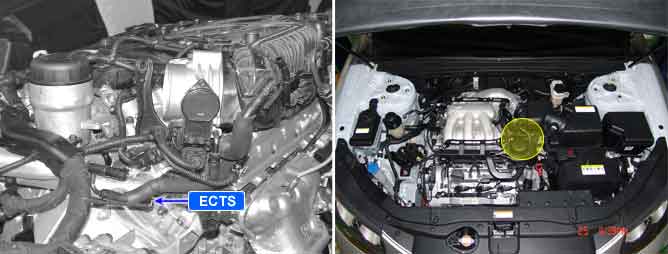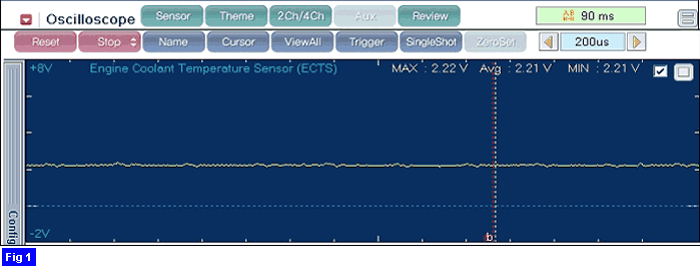

The Engine Coolant Temperature Sensor (ECTS) is located in the engine coolant passage of the cylinder head for detecting the engine coolant temperature. The ECTS uses a thermistor whose resistance changes with the temperature. The electrical resistance of the ECTS decreases as the temperature increases, and increases as the temperature decreases. The reference 5 V in the PCM is supplied to the ECTS via a resistor in the PCM. That is, the resistor in the PCM and the thermistor in the ECTS are connected in series. When the resistance value of the thermistor in the ECTS changes according to the engine coolant temperature, the output voltage also changes. During cold engine operation the PCM increases the fuel injection duration and controls the ignition timing using the information of engine coolant temperature to avoid engine stalling and improve drivability.
Checking output signals from ECTS every 80 sec. under detecting condition, if an output signal is above 4.9V for more than 40 sec., PCM sets P0118. MIL(Malfunction Indication Lamp) turns on when the malfunction lasts till consecutive 2 driving cycle.
Item | Detecting Condition | Possible cause |
DTC Strategy | ● Open, Signal high | ● Poor connection ● Open or short to battery in signal harness ● Open in ground harness ● ECTS ● PCM |
Enable Conditions | Case 1 | ● Time after start-up >120 sec. |
Case 2 | ● Time from IG "OFF" to IG "ON" > 360 min. ● Intake air temperature ≥ -10°C(14°F) ● Engine running state | |
Threshold Value | ● Engine coolant temperature sensor’s voltage >4.9V | |
Diagnosis Time | ● Continuous (More than 40 sec. failure for every 80 sec. test) | |
MIL ON Condition | ● 2 Driving Cycle |
Temp. (°C/°F) | Resistance (kΩ) | Temp. (°C/°F) | Resistance (kΩ) |
-40(-40) | 48.14 | 40(104) | 1.15 |
-20(-4) | 14.13 ~ 16.83 | 60(140) | 0.59 |
0(32) | 5.79 | 80(176) | 0.32 |
20(68) | 2.31 ~ 2.59 |

Fig 1) Temperature : 180℉
The output signals of IATS & ECTS change smoothly without any rapid changes. Those have almost same characteristic signal during the early period after start. It means that the temperatures of intake air and engine coolant are depended on the temperature of atmosphere. Meanwhile, during the warming up, the output signal of ECTS is going up increasingly. but, the output signal of IATS changes a little bit. even it may not change almost. It means that the heat of engine does not affect on the temperature of intake air.